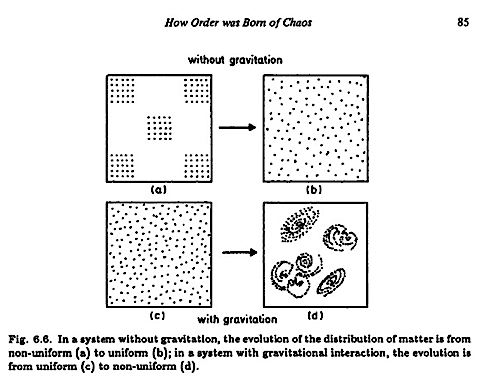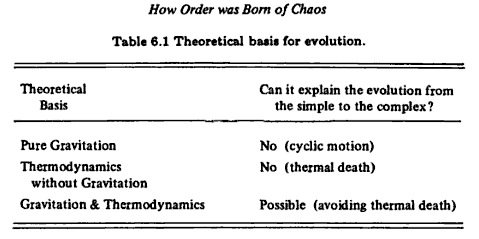There Aint No Heat Death
There’s a famous Woody Allen scene in the movie Annie Hall when the young Woody is brought to the psychiatrist’s office because he is depressed that the universe will keep expanding. Unstated in the scene was the popular notion that this constant expansion meant the universe was running down. And as Woody was wise to notice, that exhaustion should be depressing.
The scientific term for the universe running down is cosmic “heat death.” The idea behind heat death is that all the differences and distinctions we see in the universe today — all objects big and small and all energy (heat) — in the end becomes dilute with expansion until there is no differentiation of any sort between them, only 100% homogenous gray background noise. All life, all potential is gone and dead.
Cosmic heat death stems in part from the second law of thermodynamics which states that differences in heat will equalize over time. In the 1850s Lord Kelvin and others extrapolated this equalization to imagine what it meant for the universe as a whole. Given enough time the universe will eventually be equalized to total stillness. The eventuality of this end state was highly accepted and somewhat the orthodoxy in textbooks. The universe was running down to heat death.
But Freeman Dyson, the legendary physicist, makes a interesting argument about why there isn’t heat death. Writing in the New York Review of Books about James Gleicks’ new book The Information, Dyson mentions almost in passing that “Thanks to the discoveries of astronomers in the twentieth century, we now know that the heat death is a myth. The heat death can never happen, and there is no paradox.” As an explanation Dyson offers his Cooking Rule illustration:
The belief in a heat death was based on an idea that I call the cooking rule. The cooking rule says that a piece of steak gets warmer when we put it on a hot grill. More generally, the rule says that any object gets warmer when it gains energy, and gets cooler when it loses energy. Humans have been cooking steaks for thousands of years, and nobody ever saw a steak get colder while cooking on a fire. The cooking rule is true for objects small enough for us to handle. If the cooking rule is always true, then Lord Kelvin’s argument for the heat death is correct.
We now know that the cooking rule is not true for objects of astronomical size, for which gravitation is the dominant form of energy. The sun is a familiar example. As the sun loses energy by radiation, it becomes hotter and not cooler. Since the sun is made of compressible gas squeezed by its own gravitation, loss of energy causes it to become smaller and denser, and the compression causes it to become hotter. For almost all astronomical objects, gravitation dominates, and they have the same unexpected behavior. Gravitation reverses the usual relation between energy and temperature. In the domain of astronomy, when heat flows from hotter to cooler objects, the hot objects get hotter and the cool objects get cooler. As a result, temperature differences in the astronomical universe tend to increase rather than decrease as time goes on. There is no final state of uniform temperature, and there is no heat death. Gravitation gives us a universe hospitable to life. Information and order can continue to grow for billions of years in the future, as they have evidently grown in the past.

This is a lot to wrap your head around. It was total news to me. Dyson’s explanation is that extremely big objects (astronomical in size) obey a different thermodynamic law that “ordinary” objects, just as extremely small objects (quantum level and smaller) obey different energy laws from the large. The realm of the super large and super small are different from the rest of us. Dyson mentions that the famous Chinese dissident and astronomer Fang Lizhi and his wife had published the best explanation he had seen of this phenomenon in a chapter called “How Order Was Born of Chaos,” in the book Creation of the Universe. (Source of he illustration above.) Fang offers a very technical argument based on the fact that gravity will affect different kinds of energy differently.
The reason why the presence or absence of heat death is important is contained in Fang’s chapter title: the origin of order. It is harder to explain the constant emergence of increased order in the universe over time if the universe is running down to a death state. Heat death can permit temporary order, but it would not have room for unbounded unlimited order. But a universe without heat death would more easily permit what Freeman Dyson calls infinite growth “in infinite directions.” There would be no limits on how much new order could be possible.
Fang believes that gravity changes everything. An oversimplified summary of Fang’s theory is this rough equation: Radiation + Particles + Gravity == Infinite Information and Evolution, as expressed in this chart from his book.

In case you think this tidys up everything with a neat explanation, please note that we have no idea what gravity is, and no idea what causes the universe to inflate. Other than that, all is clear.:-)
The Fang/Dyson idea (for the lack of a better name) says that rather than an inexorable sinking towards heat death, the universe is biased toward a slow and steady march towards increasing differences over time. Gravity will continue to accentuate the uneven clumping of matter, and create ever more uneven energy potential, constantly building up order, even while local areas run down. But over the very long term, the universe as a whole is running up. No need to worry, Woody.


